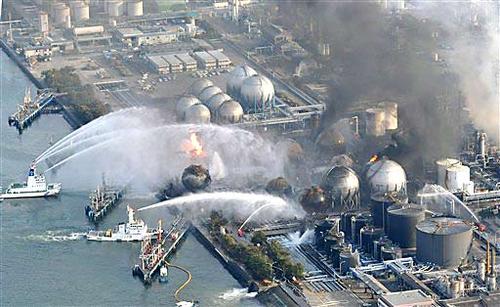Japan disasterNuclear crisis worsening; growing radiation leaks at reactors nos. 3, 4
The situation at the Fukushima Daiichi nuclear power plant appears increasingly dire, as efforts to cool overheating reactors have failed; Japanese military fire trucks are now spraying water at the plant’s no. 3 reactor; earlier efforts on Thursday to use helicopters to dump water on the rods have failed; the U.S. Nuclear Regulatory Commission chairman is particularly concerned about reactor no. 4 which houses spent fuel rods; spent fuel rods, placed in cooling tanks, are rapidly overheating as they are boiling away the water they are submerged in; the secondary containment unit at reactor no. 4 has been breached and radiation is now freely leaking out of the plant; high radiation levels are hindering efforts to repair the reactors

Fireboats attempted to fill storage pools // Source: zimbio.com
The situation at the Fukushima Daiichi nuclear power plant appears increasingly dire, as efforts to cool overheating reactors have failed.
In a desperate attempt, Japanese military fire trucks are now spraying water at the plant’s no. 3 reactor. Earlier efforts on Thursday to use helicopters to dump water on the rods have failed. Japanese military helicopters made four passes dropping a total of 8,000 gallons of seawater on reactor no. 3 to little effect.
According to Japanese officials, the reactor needs about 12,000 gallons of water a day to keep from overheating.
It appears that the water missed the reactor and the military said that they had not noticed any decreases in temperature.
Plans to drop water on the plant’s no. 4 reactor have been postponed.
Gregory Jaczko, the U.S. Nuclear Regulatory Commission chairman, is particularly concerned about reactor no. 4 which houses spent fuel rods.
The reactor was not active at the time of the massive 8.9 magnitude earthquake that shook Japan, but the subsequent tsunami knocked out the power supply which kept cool water circulating around the spent fuel rods.
The tanks are usually forty-five feet deep and the fuel rods are typically stored in the lower fifteen feet of the pool. When the water pumps failed, the spent rods began to heat the water rapidly boiling it away.
The spent fuel rods at reactor no. 4 are particularly troublesome as they were only removed from the reactor in December 2010, and therefore generate more heat than the spent fuel at other reactors.
As the water boils, the steam generated carries radioactive particles that are eventually released into the air. If the rods remain exposed and out of water for too long they will eventually melt and emit massive amounts of radiation.
These problems have been exacerbated by the fact that the secondary containment unit at reactor no. 4 has been breached and radiation is now freely leaking out of the plant.
Officials are uncertain if there is any water left in the storage pool.
Yoshitaka Nagayama, a spokesman for Japan’s Nuclear and Industrial Safety Agency, said, “Because we have been unable to go to the scene, we cannot confirm whether there is water left or not in the spent fuel pool at Reactor No. 4.”
High radiation levels have further complicated efforts to cool the plants.
Testifying before Congress on Wednesday, Jaczko said, “We believe that radiation levels are extremely high, which could possibly impact the ability to take corrective measures.”
The peak levels of radiation there “would be lethal within a fairly short period of time,” he said.
According to Hidehiko Nishiyama, deputy director-general of the Nuclear and Industrial Safety Agency, radiation levels of approximately 250 millisievert an hour were detected 100 feet above the plant.
Radiation levels have dramatically risen and fallen over the past several days. On Tuesday the International Atomic Energy Agency (IAEA) measured radiation levels as high as 400 millisieverts an hour before they plunged to 0.6 millisievert an hour.
The World Nuclear Association says that 50 millisievert of radiation a year is the lowest dose at which there is evidence of cancer in humans. The average person receives about one to two millisieverts of radiation from natural sources like the sun a year.
Jaczko warned that resolving the crisis could “take time, possibly weeks.”
Officials are also closely monitoring spent fuel pools at reactors no. 3, 5, and 6 where water levels may have dropped as well.
